Abstract
Loxapine is a typical neuroleptic that shows great structural and functional homology to the atypical antipsychotic clozapine. Chronic loxapine treatment is usually associated with extrapyramidal symptoms (EPS), whereas clozapine treatment is not. Conversely, loxapine does not produce the agranulocytosis that often results from protracted clozapine treatment. Earlier studies of loxapine have usually implicated D2 receptor blockade as the cause of the tardive dyskinesia that occurs with chronic treatment. More recently, loxapine's ability to potentiate serotonergic neurotransmission has also been implicated. In this study, the pharmacological affinities of loxapine for the dopamine D1, D2, D4, as well as serotonin-2 (5-HT2) and NMDA receptor subtypes, were investigated through direct radioreceptor assays. The findings indicate that loxapine displays an extremely strong binding affinity for dopamine D4 and serotonin 5-HT2 receptors, which suggests that both serotonergic and dopaminergic mechanisms contribute to the antipsychotic drug action and EPS associated with loxapine in the treatment of schizophrenia.
Full text
PDF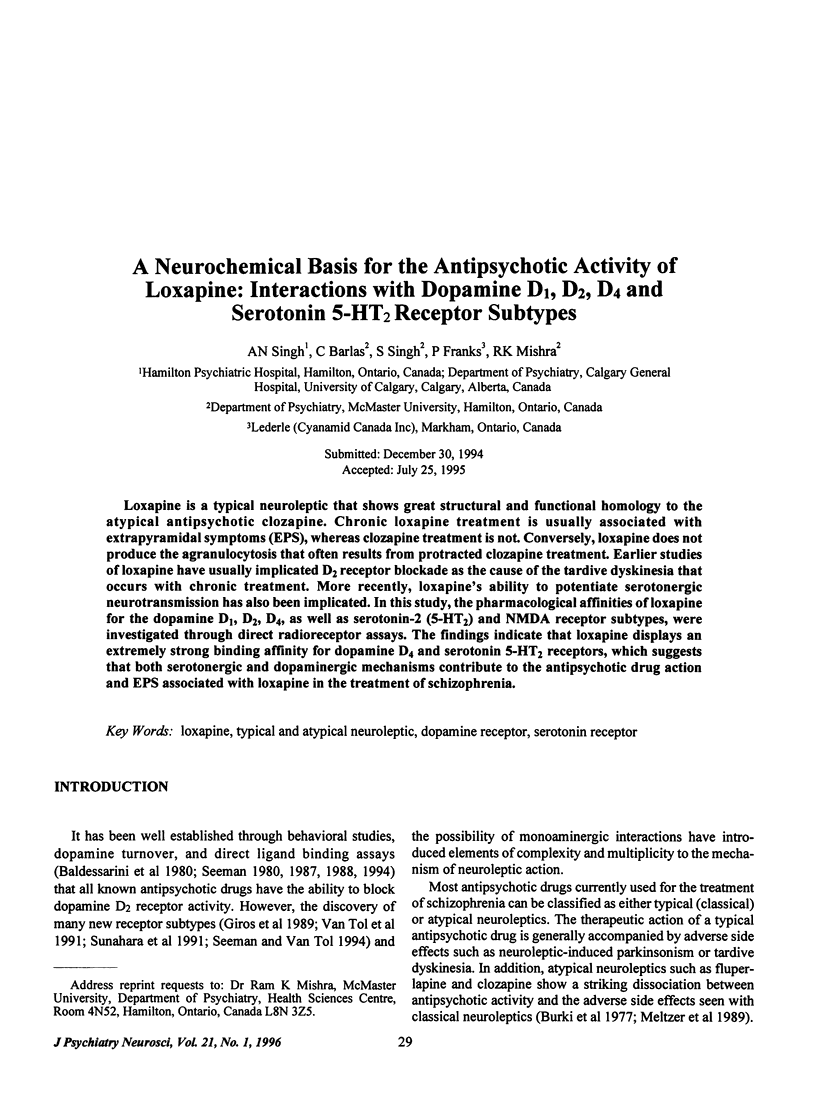
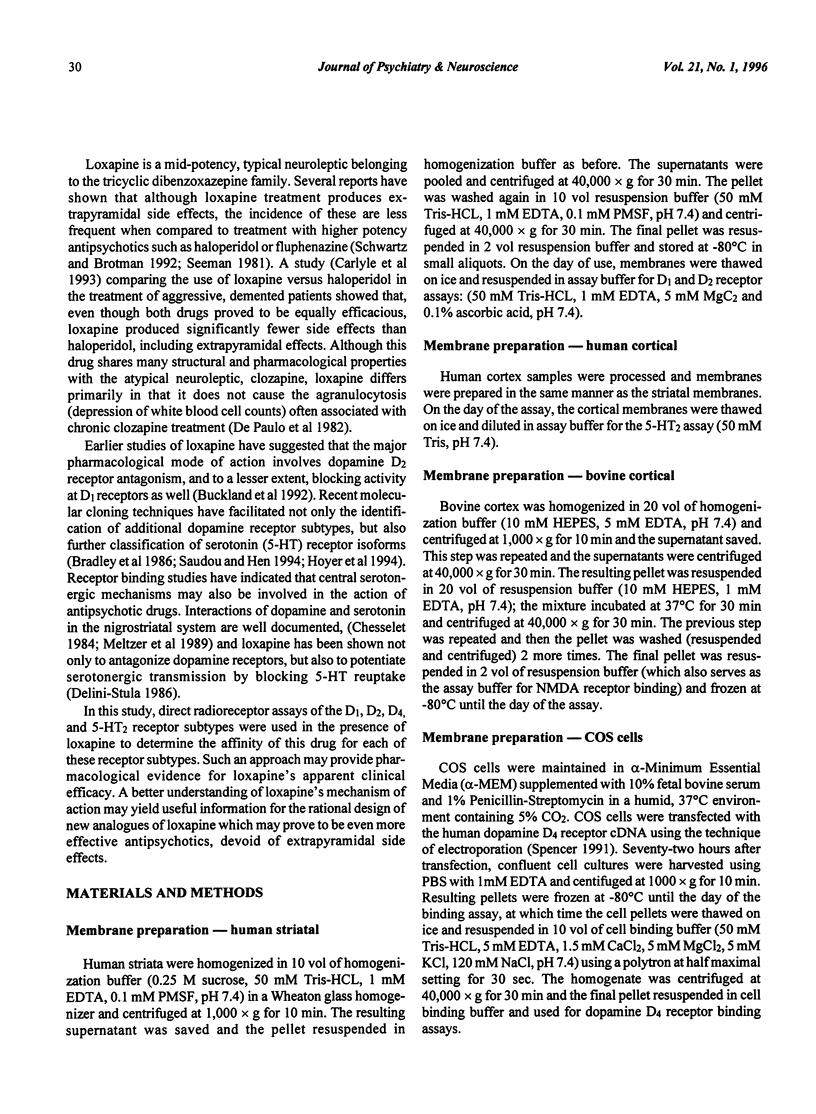
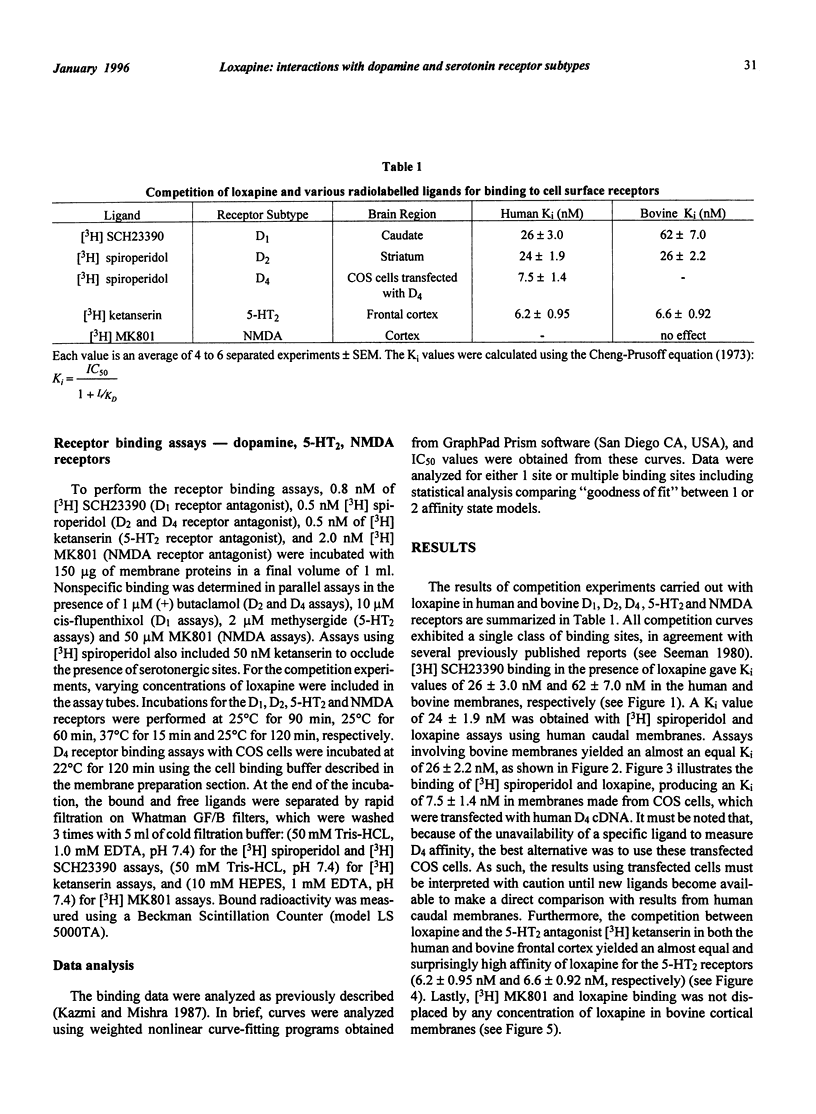
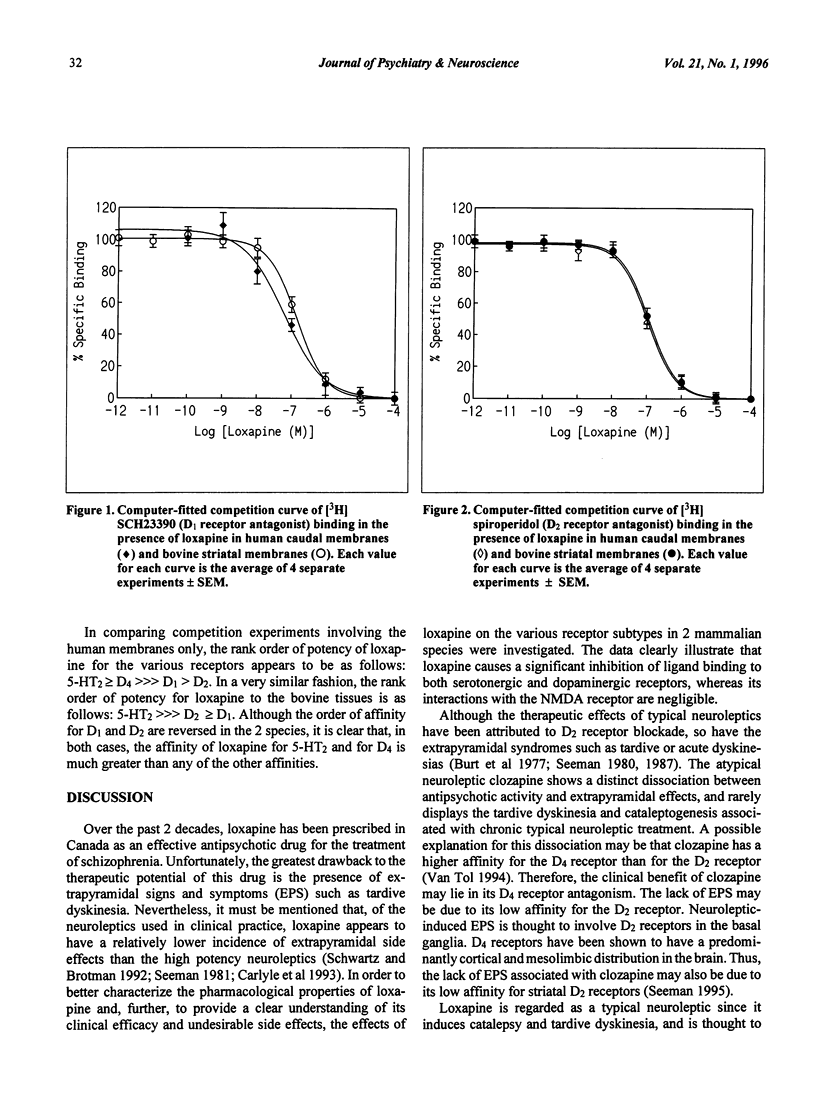
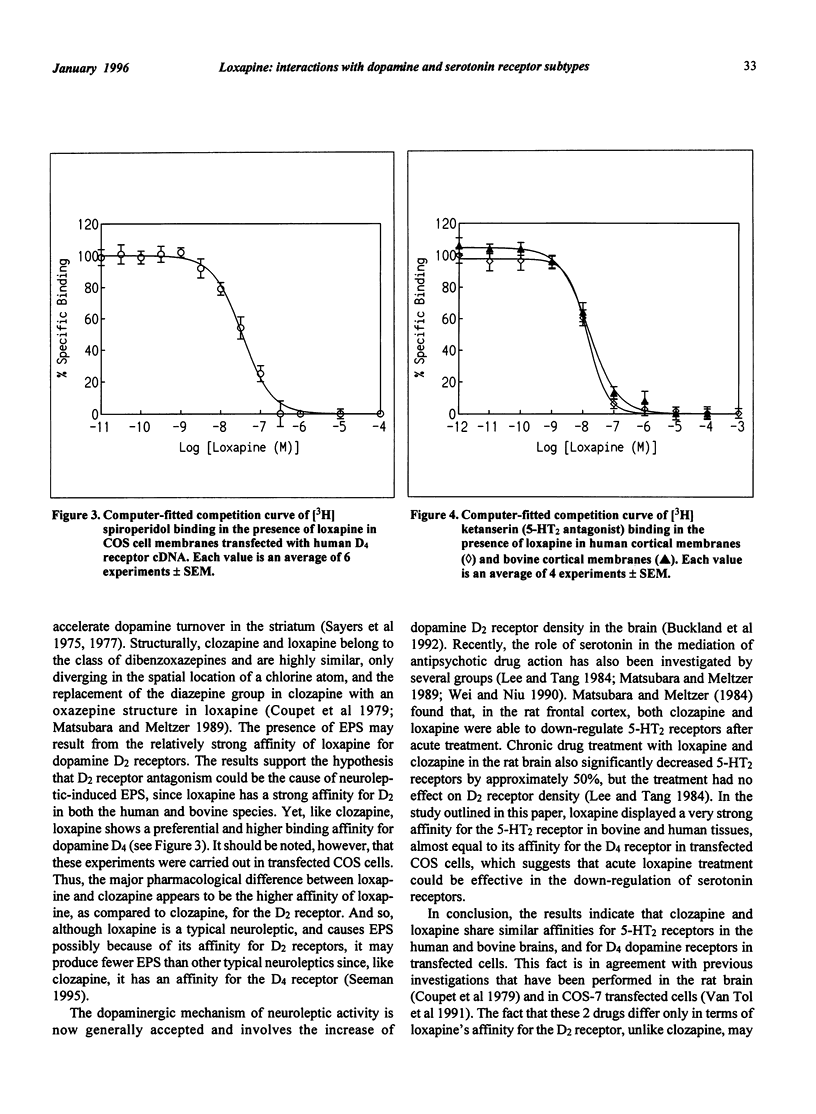
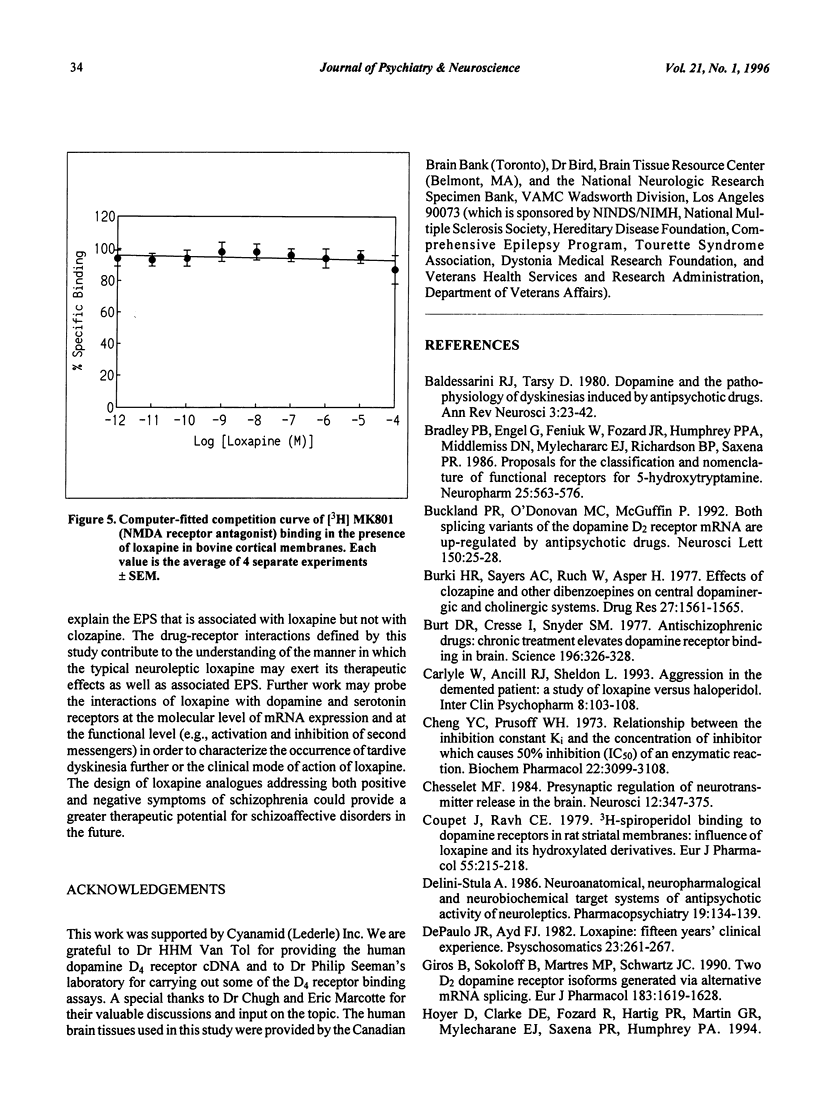
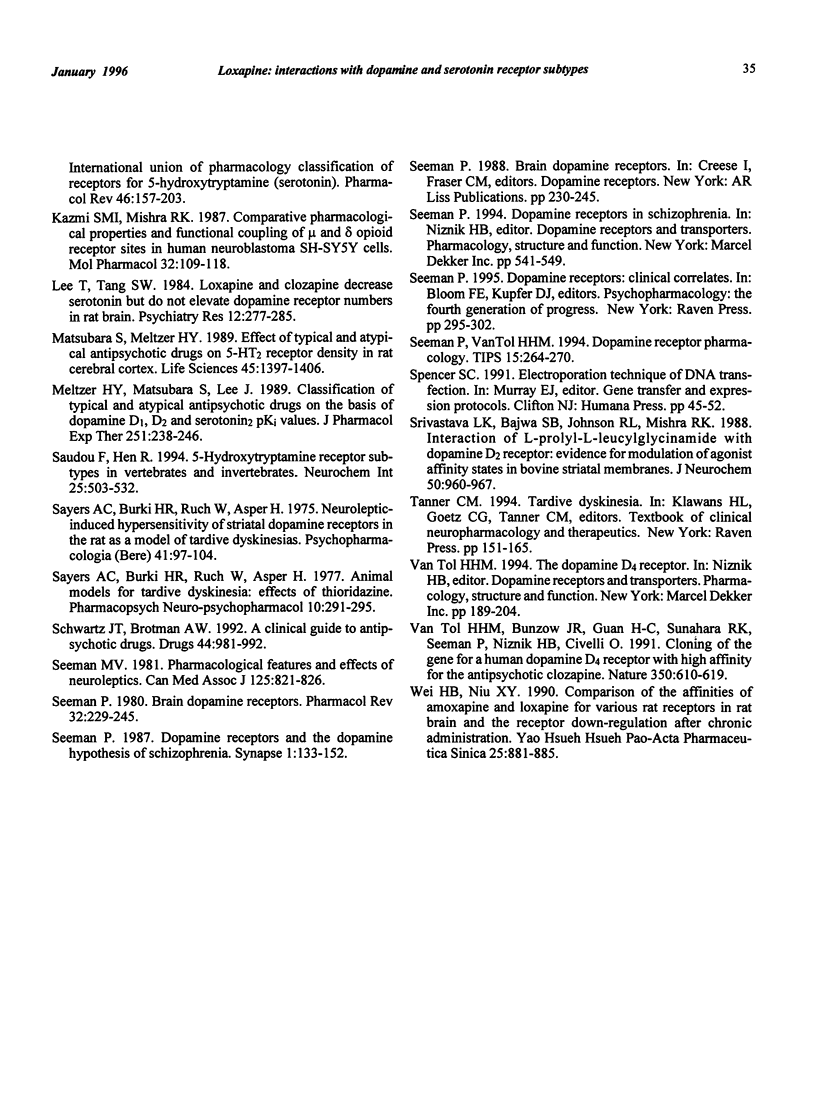
Selected References
These references are in PubMed. This may not be the complete list of references from this article.
- Baldessarini R. J., Tarsy D. Dopamine and the pathophysiology of dyskinesias induced by antipsychotic drugs. Annu Rev Neurosci. 1980;3:23–41. doi: 10.1146/annurev.ne.03.030180.000323. [DOI] [PubMed] [Google Scholar]
- Bradley P. B., Engel G., Feniuk W., Fozard J. R., Humphrey P. P., Middlemiss D. N., Mylecharane E. J., Richardson B. P., Saxena P. R. Proposals for the classification and nomenclature of functional receptors for 5-hydroxytryptamine. Neuropharmacology. 1986 Jun;25(6):563–576. doi: 10.1016/0028-3908(86)90207-8. [DOI] [PubMed] [Google Scholar]
- Buckland P. R., O'Donovan M. C., McGuffin P. Both splicing variants of the dopamine D2 receptor mRNA are up-regulated by antipsychotic drugs. Neurosci Lett. 1993 Feb 5;150(1):25–28. doi: 10.1016/0304-3940(93)90099-7. [DOI] [PubMed] [Google Scholar]
- Burt D. R., Creese I., Snyder S. H. Antischizophrenic drugs: chronic treatment elevates dopamine receptor binding in brain. Science. 1977 Apr 15;196(4287):326–328. doi: 10.1126/science.847477. [DOI] [PubMed] [Google Scholar]
- Bürki H. R., Sayers A. C., Ruch W., Asper H. Effects of clozapine and other dibenzo-epines on central dopaminergic and cholinergic systems. Structure-activity relationships. Arzneimittelforschung. 1977;27(8):1561–1565. [PubMed] [Google Scholar]
- Carlyle W., Ancill R. J., Sheldon L. Aggression in the demented patient: a double-blind study of loxapine versus haloperidol. Int Clin Psychopharmacol. 1993 Summer;8(2):103–108. doi: 10.1097/00004850-199300820-00004. [DOI] [PubMed] [Google Scholar]
- Cheng Y., Prusoff W. H. Relationship between the inhibition constant (K1) and the concentration of inhibitor which causes 50 per cent inhibition (I50) of an enzymatic reaction. Biochem Pharmacol. 1973 Dec 1;22(23):3099–3108. doi: 10.1016/0006-2952(73)90196-2. [DOI] [PubMed] [Google Scholar]
- Chesselet M. F. Presynaptic regulation of neurotransmitter release in the brain: facts and hypothesis. Neuroscience. 1984 Jun;12(2):347–375. doi: 10.1016/0306-4522(84)90058-7. [DOI] [PubMed] [Google Scholar]
- Coupet J., Rauh C. E. 3H-Spiroperidol binding to dopamine receptors in rat striatal membranes: influence of loxapine and its hydroxylated metabolites. Eur J Pharmacol. 1979 Apr 15;55(2):215–218. doi: 10.1016/0014-2999(79)90396-0. [DOI] [PubMed] [Google Scholar]
- DePaulo J. R., Jr, Ayd F. J., Jr Loxapine: fifteen years' clinical experience. Psychosomatics. 1982 Mar;23(3):261–271. doi: 10.1016/s0033-3182(82)73416-4. [DOI] [PubMed] [Google Scholar]
- Delini-Stula A. Neuroanatomical, neuropharmacological and neurobiochemical target systems for antipsychotic activity of neuroleptics. Pharmacopsychiatry. 1986 Jul;19(4):134–139. doi: 10.1055/s-2007-1017171. [DOI] [PubMed] [Google Scholar]
- Hoyer D., Clarke D. E., Fozard J. R., Hartig P. R., Martin G. R., Mylecharane E. J., Saxena P. R., Humphrey P. P. International Union of Pharmacology classification of receptors for 5-hydroxytryptamine (Serotonin). Pharmacol Rev. 1994 Jun;46(2):157–203. [PubMed] [Google Scholar]
- Kazmi S. M., Mishra R. K. Comparative pharmacological properties and functional coupling of mu and delta opioid receptor sites in human neuroblastoma SH-SY5Y cells. Mol Pharmacol. 1987 Jul;32(1):109–118. [PubMed] [Google Scholar]
- Lee T., Tang S. W. Loxapine and clozapine decrease serotonin (S2) but do not elevate dopamine (D2) receptor numbers in the rat brain. Psychiatry Res. 1984 Aug;12(4):277–285. doi: 10.1016/0165-1781(84)90044-1. [DOI] [PubMed] [Google Scholar]
- Matsubara S., Meltzer H. Y. Effect of typical and atypical antipsychotic drugs on 5-HT2 receptor density in rat cerebral cortex. Life Sci. 1989;45(15):1397–1406. doi: 10.1016/0024-3205(89)90027-1. [DOI] [PubMed] [Google Scholar]
- Meltzer H. Y., Matsubara S., Lee J. C. Classification of typical and atypical antipsychotic drugs on the basis of dopamine D-1, D-2 and serotonin2 pKi values. J Pharmacol Exp Ther. 1989 Oct;251(1):238–246. [PubMed] [Google Scholar]
- Saudou F., Hen R. 5-Hydroxytryptamine receptor subtypes in vertebrates and invertebrates. Neurochem Int. 1994 Dec;25(6):503–532. doi: 10.1016/0197-0186(94)90150-3. [DOI] [PubMed] [Google Scholar]
- Sayers A. C., Bürki H. R., Ruch W., Asper H. Animal models for tardive dyskinesia: effects of thioridazine. Pharmakopsychiatr Neuropsychopharmakol. 1977 Sep;10(5):291–295. doi: 10.1055/s-0028-1094551. [DOI] [PubMed] [Google Scholar]
- Sayers A. C., Bürki H. R., Ruch W., Asper H. Neuroleptic-induced hypersensitivity of striatal dopamine receptors in the rat as a model of tardive dyskinesias. Effects of clozapine, haloperidol, loxapine and chlorpromazine. Psychopharmacologia. 1975;41(2):97–104. doi: 10.1007/BF00421063. [DOI] [PubMed] [Google Scholar]
- Schwartz J. T., Brotman A. W. A clinical guide to antipsychotic drugs. Drugs. 1992 Dec;44(6):981–992. doi: 10.2165/00003495-199244060-00007. [DOI] [PubMed] [Google Scholar]
- Seeman M. V. Pharmacologic features and effects of neuroleptics. Can Med Assoc J. 1981 Oct 15;125(8):821–826. [PMC free article] [PubMed] [Google Scholar]
- Seeman P. Brain dopamine receptors. Pharmacol Rev. 1980 Sep;32(3):229–313. [PubMed] [Google Scholar]
- Seeman P. Dopamine receptors and the dopamine hypothesis of schizophrenia. Synapse. 1987;1(2):133–152. doi: 10.1002/syn.890010203. [DOI] [PubMed] [Google Scholar]
- Seeman P., Van Tol H. H. Dopamine receptor pharmacology. Trends Pharmacol Sci. 1994 Jul;15(7):264–270. doi: 10.1016/0165-6147(94)90323-9. [DOI] [PubMed] [Google Scholar]
- Srivastava L. K., Bajwa S. B., Johnson R. L., Mishra R. K. Interaction of L-prolyl-L-leucyl glycinamide with dopamine D2 receptor: evidence for modulation of agonist affinity states in bovine striatal membranes. J Neurochem. 1988 Mar;50(3):960–968. doi: 10.1111/j.1471-4159.1988.tb03005.x. [DOI] [PubMed] [Google Scholar]
- Van Tol H. H., Bunzow J. R., Guan H. C., Sunahara R. K., Seeman P., Niznik H. B., Civelli O. Cloning of the gene for a human dopamine D4 receptor with high affinity for the antipsychotic clozapine. Nature. 1991 Apr 18;350(6319):610–614. doi: 10.1038/350610a0. [DOI] [PubMed] [Google Scholar]
- Wei H. B., Niu X. Y. [Comparison of the affinities of amoxapine and loxapine for various receptors in rat brain and the receptor down-regulation after chronic administration]. Yao Xue Xue Bao. 1990;25(12):881–885. [PubMed] [Google Scholar]


